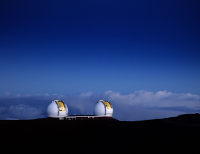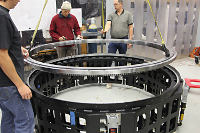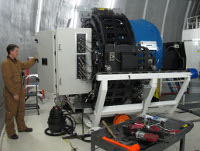How do you collect data from stars thousands of light years away while positioning a 300-ton telescope to within a fraction of a human hair? You use a high-tech spectrometer called MOSFIRE, rotating on a Kaydon bearing.

With MOSFIRE, astronomers can gather spectra at near-infrared wavelengths (invisible to the human eye) and even penetrate cosmic dust clouds to investigate the formation of stars and galaxies. The instrument can survey 46 objects at once and switch targets in minutes, instead of the usual one or two days.

"I reckon that MOSFIRE will observe very faint targets more than a hundred times faster than has ever been possible," said Caltech astronomer Chuck Steidel, its co-principal investigator. "All the observations my group and I have done in near-infrared spectroscopy with Keck over the last 10 years could be done in just one night with MOSFIRE."
The Multi-Object Spectrometer for Infra-Red Exploration (MOSFIRE) is 25 times more light-sensitive than other instruments of its kind and can observe vastly more cosmic objects on any given night. It arrived in February at the W.M. Keck Observatory in Hawaii and will be fully commissioned in September. The observatory, near the 14,000-foot summit of Mauna Kea, on the island of Hawaii, is a scientific partnership of the California Institute of Technology, the University of California, and NASA.
One Bearing Meets All Requirements
"Our orientation changes constantly as we track the stars, so the bearing must handle many load combinations, both axial and radial," said Mike Pollard, a Keck engineer. "Astronomers with 20-30 years' experience say the Kaydon bearing is the best they've ever seen."
Pollard said the Kaydon bearing was the only one to meet all the requirements, which include:
smooth performance (very little torque variation) mounting to a structure that is slightly compliant (i.e., not stiff) very little wobble – almost no variation from inner race axis to outer race axis fit the existing space harsh environment – at 14,000 feet, amidst volcanic cinder dust very low maintenance.

The custom bearing is hard to categorize, but is more slewing ring than thin section, according to Kaydon engineer Wayne TenBrink. About 2 meters in diameter, it features a back-to-back duplex design with integral gearing. The inner and outer race are thinner than usual for a slewing ring bearing this size, and each race has two ball paths to spread the load and minimize torque variation.
Since minimizing torque is essential to maintaining the stability needed for reliable data, the Keck Observatory has a lot riding on the Kaydon bearing. By mating MOSFIRE with the light-gathering power of the 10-meter Keck I telescope and the clear skies of Mauna Kea, scientists expect new, exciting discoveries will be made about the universe.





